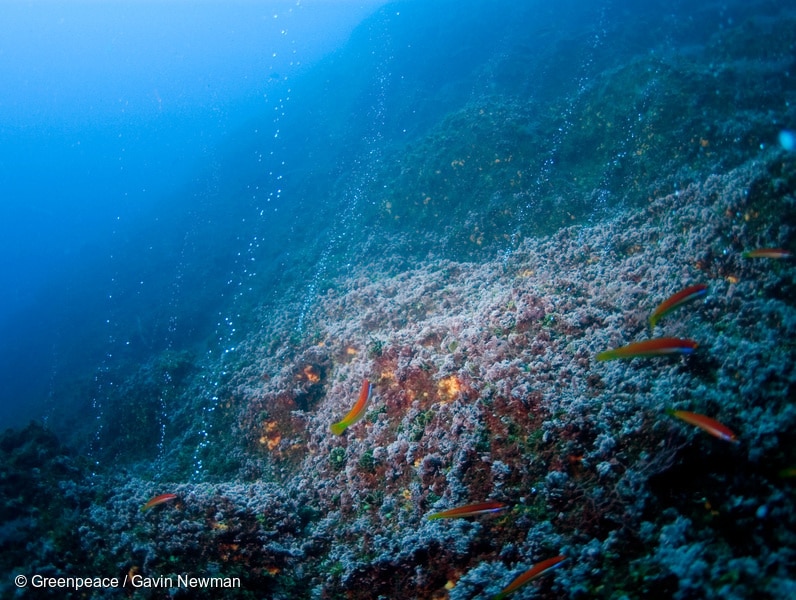

Hydrothermal vents at Dom João De Castro. They are unusually shallow and support unique communities of organisms, often with special properties which interest both scientists and industry. UAC is conducting research here. The area has been designated a Natura 2000 site. Greenpeace
By Willie Mackenzie
When it comes to being otherworldly, alien and bizarre, the ocean has plenty to fuel the imagination and make your jaw drop: giant scuttling bugs, jelly-like blobfish, slimy mucus-drenched hagfish, hairy armed lobsters and almost anything else you could imagine.
It’s no big surprise that Hollywood science fiction films so often look to the deep for their monsters, landscapes and mystery. After all, the deep ocean is more alien to us than the surface of the moon.
But bizarrely, some scientists think the ocean floor might well be the very place where life on our planet first evolved.

The spiral tube worm, or Sabella Spallanzanii, lives in membranous tubes, often reinforced by the inclusion of mud particles and has a feathery, filter-feeding crown that can be quickly withdrawn into the tube when danger threatens.
Gavin Newman / Greenpeace
Discovery of Hydrothermal Vents
One of the hottest candidates for creating the right conditions are deep sea “hydrothermal” vents, where super-heated water and chemicals meet. These vents exist far below the reach of sunlight, in an area devoid of any oxygen. They’re created at the places where giant tectonic plates meet, by the heat from the inner Earth pushing through the crust of the planet.
Hydrothermal vents were only discovered in 1977 – and astonished scientists with their towering chimneys and bizarre animals discovered around them. Giant tube worms, bacteria-eating crabs and other surreal creatures somehow thriving at great depths, clustered around columns billowing out “smoking” superheated, mineral-rich seawater.
This discovery challenged what people thought about life on Earth, and even more so when “alkaline” versions were discovered in 2000. Caustic conditions, similar to weak bleach, or bicarbonate of soda, seemed even more unlikely to support life. Yet they did.
The Lost City: The Real Primordial Soup?
The Lost City is the best known of these hydrothermal vents — a collection of turrets, towers and chimneys that could be as much as 120,000 years old.
Research shows that these vents are creating hydrocarbons — molecules that are essential for all life on Earth. Could it be that churning chemicals and minerals in superheated seawater in places like the Lost City were actually where life started? Is this the real primordial soup?
The honest answer is — we still don’t know. In the last couple of decades, scientists have struggled to survey and understand the mysteries of the Lost City.
But as research continues to try and answer these questions, the seabed has attracted attention from industry keen to exploit the minerals and metals down there too.

Hydrothermal vents at Dom João De Castro.
Greenpeace / Gavin Newman
Monster Machines at the Ready
We don’t know very much about the deep sea, and we know even less about remote, inhospitable deep sea vents. Though they exist in extreme chemical and physical conditions, they seem to be very fragile and precarious.
Yet even before scientists have started to scratch the surface of understanding these remarkable environments, they are at risk of being damaged or destroyed forever by industries keen to mine minerals from the deep sea.
Licenses have already been granted to explore for mining the seafloor with monster machines — which risk wrecking these places before they are even understood.

Underwater footage of seamounts in the Azores, Princess Alice Banks.
Greenpeace
A Wake-Up Call
The rush to exploit the deep ocean, before we even understand it, has to be a wake-up call.
It’s not as if the public is clamoring for the seafloor to be ripped up for us to get a new gadget (especially when companies can’t even get their act together to reclaim and recycle the materials we already have!). Not only are we threatening unique marine life, but we might destroy these places forever.
That’s why Greenpeace’s Pole to Pole expedition is sailing to the Lost City this summer with the scientist who discovered this wonder of the deep ocean, to learn more about its mysteries and make the case for protection, rather than exploitation.
Did life on Earth begin in the cauldron of chemical soup around deep sea hydrothermal vents? I don’t know. But I do know that we’re already harming enough species and habitats, and we have no justifiable reason to trash the fragile deep sea and all the wonderfully weird marine life that makes its home there.

The Esperanza arriving to the Azores for the Lost City Leg of the Pole to Pole Ship Tour.
Barbara Sanchez Palomero / Greenpeace
Willie Mackenzie is an Oceans Campaigner with Greenpeace International.

 233k
233k  41k
41k  Subscribe
Subscribe 